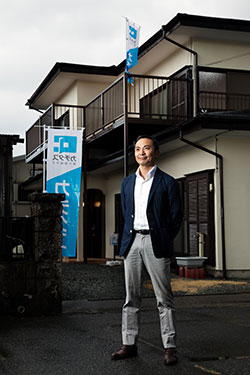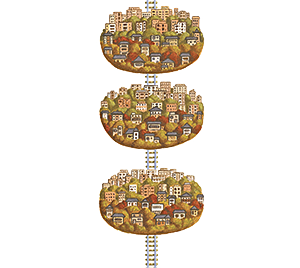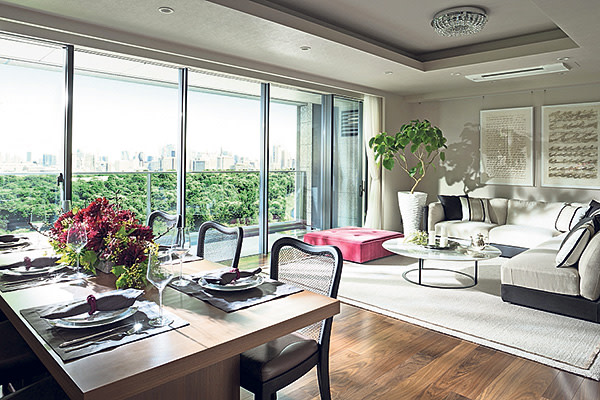Is this the solution to Japan’s glut of empty homes?

Simply sign up to the Life & Arts myFT Digest -- delivered directly to your inbox.
It was once a treasured family home, but by the time Katsutoshi Arai bought it the house was empty — a rubbish-strewn, fly-infested blight on a small Japanese neighbourhood.
“It was overflowing with garbage — it made you want to vomit,” says Arai, president of the estate agency Katitas, as he recounts what his staff went through to fix it up. “When I went to see it again it was transformed,” he says. “The neighbourhood was so happy.”
The house in question was an akiya — an empty house — and more than 8m are scattered across Japan. With the country’s population falling by 271,058 last year, and many of those who remain migrating to Tokyo, the Japanese are leaving their houses behind.
It is, on one hand, an unprecedented social problem. Whereas countries such as the UK are suffering a terrible housing shortage, Japan’s government has just passed a new law to tackle the glut of abandoned, decaying houses.
On the other hand, the akiya are an opportunity — and not just a business opportunity, but a chance to reimagine Japan’s postwar culture of disposable housing and suburban sprawl. The akiya are a symbol of decline, yes, but they may also be the path to a better future.

Katitas has seized this opportunity with an entirely new business model. “Most estate agents are intermediaries — they connect a buyer with a seller and take a fee,” says Arai. “We buy second-hand houses directly, refurbish them, and then sell them ourselves.”
In the past two-and-a-half years, Katitas has begun doing this on an industrial scale, turning over 3,000 houses last year. About 40 per cent of the properties it buys are vacant. “The most common reason for selling to us is inheritance,” says Arai. “When someone in their forties or fifties inherits, they usually have their own house already.”
A modest family home in the town of Kiryu, two hours north of Tokyo, is a sample of what Katitas has to offer. Inside, the air is cool and smells of fresh tatami mats. There are signs of the previous owner’s love — elegant wooden carvings in the living room — as well as a gleaming new kitchen, bathroom and boiler installed by Katitas.

To a European, any wooden house feels a little flimsy, but it is a pleasant and serviceable home. By international standards it is also extremely cheap: Katitas wants Y8.98m ($73,262). Hideyuki Hara, a local Katitas agent, says as much as half of the price went into refurbishment. The company is coy about what it pays, but hints that some akiya cost only a few thousand dollars.
“Our buyers are people who want a good house at a low price,” says Arai. “Perhaps they’re a first-time buyer in their thirties, living in a rented apartment, and their neighbours complain about the children’s noise. The houses we sell are often cheaper than renting — they cost Y30,000 or Y40,000 a month.”
“We see about 10 houses for each one we buy,” he says. “About half of those we reject [because] we can’t agree on price. For others, it’s because the structure is not sound, or it’s just too far out in the countryside. In some marginal villages the demand is basically zero.”

That Japanese buyers are willing even to consider buying a second-hand home is an important departure. Japan is a country shaped by nature, and in the real estate market nature has two forms: earthquakes and white-footed ants. One or the other destroys every wooden structure in the end, and so Japan builds disposable houses, designed to last for 30 years.
The historical pattern is to live in an extended family compound, with each generation razing an old structure and building a new house on the ancestral land. Whereas 90 per cent of dwellings sold in the US or UK are second-hand, in Japan that figure is just 15 per cent, showing the dominance of new houses.
But constantly building new houses with a declining population means ever more akiya. According to the Fujitsu Research Institute, almost one in three of Japan’s houses will be left empty by 2033 at the current pace of construction, compared with 23 per cent if the pace of new building halves.

Empty houses cause a host of problems. At the most basic level, they depress a neighbourhood, but the 1.05m rotten or damaged houses are worse: they attract pests or turn into rubbish dumps.
The new law lets local governments designate such houses and penalise owners who do not demolish them, care for them, or bring them back into use. Arai hopes the prospect of such penalties will increase the supply of sellers to Katitas.
There is a further problem for cities because akiya do not occur in helpful clusters. Rather than an urban cancer, to be cut out by abandoning the declining neighbourhood, they are a kind of urban measles. Individual houses fall empty in every neighbourhood when their owners grow old.
For Japan’s mayors, measles is the more painful disease. They are left with the same costs — the same length of road and number of primary schools — but an ever-falling population of taxpayers who can pay for it all. That makes the akiya one impetus behind a new movement in Japanese urban planning: the compact city.

Urban Japan grew with zoning rules but no concept of a greenbelt or limits on the extent of towns. Its cities sprawl into suburbs where rice paddies mingle with family homes. But now, as they decline, some of Japan’s cities are trying to impose a plan.
One such city is Toyama on Japan’s western coast. “Put simply, we’re trying to change a city like Los Angeles into a city like San Francisco,” says Masashi Mori, the city’s charismatic mayor. (Among his innovations: free tram travel for anybody carrying a bouquet of flowers, to smarten things up.)
The idea is to make Toyama resemble “dumplings on a skewer”, with clusters of population (the dumplings), along new or revived light rail lines (the skewers), into which Mori is pouring cash. To lure people out of the suburbs, Toyama pays a subsidy to anybody who moves to the city centre or one of its population “dumplings”.
Progress is slow but the hope is that any akiya inside the compact city will find new owners. From 28 per cent of Toyama residents in the compact city 10 years ago, the percentage is up to 32 per cent, and the goal for 2025 is 42 per cent. “If we don’t do this then the burden on future generations will be great,” says Mori.

The surplus of housing in Japan, combined with the ardour of Chinese investors for offshore real estate, suggests another business opportunity: selling Japan’s akiya to China. Arai says a few such investors are popping up. “We had a Taiwanese buyer in Okinawa, and a house in Saitama sold to someone in Hong Kong who didn’t even come to look at it,” he says. For Japan’s resort areas, overseas buyers may well be the future. But for its regional cities, where akiya are most common, the falling population may still be a blessing as well as a curse.
“Personally, I think it’s not so bad,” says Arai. ”When I was growing up, what I always heard is that Japan has a huge population, the houses are small, and you won’t be able to buy one. Now you can buy a fairly big house for a low cost, refurbish it and live well.”
How long can Tokyo’s property boom continue?

Demographic change is hurting Japan’s regions but in Tokyo — with 38m people, still the world’s largest metropolis by far — the residential property market is booming.
Estate agents report cases of swanky apartments in central Tokyo selling at prices up 30 to 50 per cent on 2012. The broader official index for Tokyo condominiums has risen about 20 per cent in the past couple of years.
The surge partly reflects the depth of the 2011-12 doldrums, when Japan’s economy was going nowhere, and the Fukushima nuclear disaster prompted some long-time foreign residents to give up and leave the country.
Since then, the massive stimulus by the Bank of Japan has lowered mortgage rates and weakened the yen, attracting a wave of Chinese buyers. The mood changed even more in 2013 when Tokyo won its bid to host the 2020 Olympics, while a rise in inheritance tax has made new Tokyo apartments appealing to Japanese buyers, who can use accelerated depreciation to lower their bill.
The question looming over the market is how long Tokyo can prosper as population decline accelerates over the next decade. The capital’s population is still rising because of migration and is not projected to peak until 2020.
After that the decline will be steep — but the trend so far is rising vacancies on the periphery, as the whole Japanese real estate market collapses like a souffle on to Tokyo’s glittering urban core.
Robin Harding is the FT’s Tokyo bureau chief
Photographs: Ko Sasaki
Illustration by James Fryer
Comments